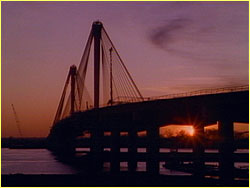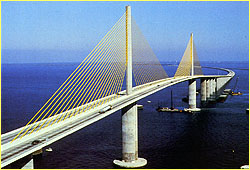 |
 |
Cable-stayed bridges may look similar to suspension bridges—both have roadways that hang from cables and both have towers. But the two bridges support the load of the roadway in very different ways. The difference lies in how the cables are connected to the towers. In suspension bridges, the cables ride freely across the towers, transmitting the load to the anchorages at either end. In cable-stayed bridges, the cables are attached to the towers, which alone bear the load. The cables can be attached to the roadway in a variety of ways. In a radial pattern, cables extend from several points on the road to a single point at the top of the tower. In a parallel pattern, cables are attached at different heights along the tower, running parallel to one other.
Try It! How do cable-stayeds work? Stand up and hold your arms out horizontally at each side. Imagine that your arms are a bridge, and your head is a tower in the middle. In this position, your muscles are holding up your arms. Try making cable-stayeds to support your arms. Take a piece of rope (about five feet long), and have a partner tie each end of the rope to each of your elbows. Then lay the middle of the rope on top of your head. The rope acts as a cable-stayed and holds your elbows up.  Have your partner tie a second piece of rope (about 6 feet long) to each wrist.
Lay the second rope over your head. You now have two cable-stayeds. Where do
you feel a pushing force, or compression? Notice how the cable-stayeds transfer
the load of the bridge (your arms) to the tower (your head).
Have your partner tie a second piece of rope (about 6 feet long) to each wrist.
Lay the second rope over your head. You now have two cable-stayeds. Where do
you feel a pushing force, or compression? Notice how the cable-stayeds transfer
the load of the bridge (your arms) to the tower (your head).Even though cable-stayed bridges look futuristic, the idea for them goes back a long way. The first known sketch of a cable-stayed bridge appears in a book called Machinae Novae published in 1595, but it wasn't until this century that engineers began to use them. In post-World War II Europe, where steel was scarce, the design was perfect for rebuilding bombed out bridges that still had standing foundations. Cable-stayed bridges began to be erected in the United States only recently, but the response has been passionate. For medium-length spans (those between 500 and 2,800 feet), cable-stayeds are fast becoming the bridge of choice. Compared to suspension bridges, cable-stayeds require less cable, can be constructed out of identical pre-cast concrete sections, and are faster to build. The result is a cost-effective bridge that is undeniably beautiful.
back to intro Photo: ASCE NOVA Builds a Rainbow Bridge | Bridge the Gap | Nature's Miracle Material China's Age of Invention | Resources | Transcript Medieval Siege | Pharaoh's Obelisk | Easter Island | Roman Bath | China Bridge | Site Map Editor's Picks | Previous Sites | Join Us/E-mail | TV/Web Schedule About NOVA | Teachers | Site Map | Shop | Jobs | Search | To print PBS Online | NOVA Online | WGBH © | Updated November 2000 |
 Cable-stayed bridge
Cable-stayed bridge Parallel attachment pattern
Parallel attachment pattern
 Radial attachment pattern
Radial attachment pattern
 Sunshine Skyway bridge
Sunshine Skyway bridge